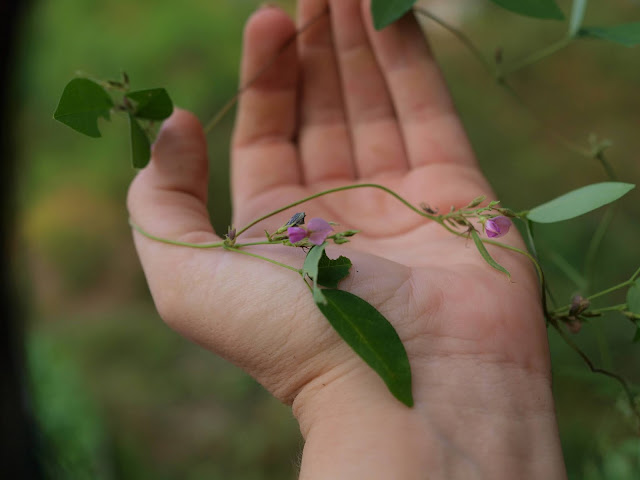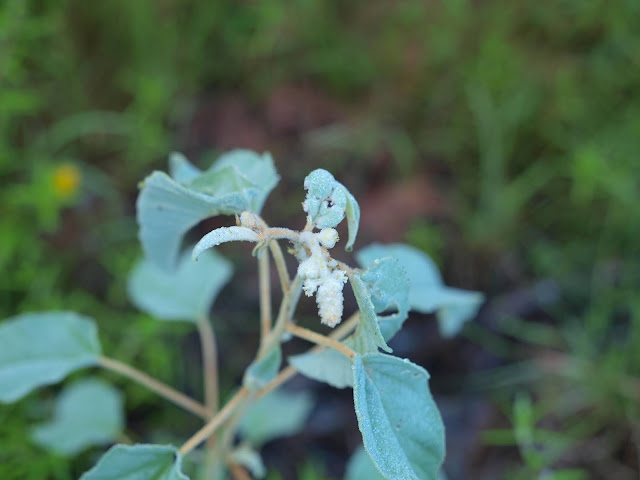August Fifth A Weed by Any Other Name
So, what is this weed?
I've been told it is the reason this place is called 'pea ridge.' It is definitely in the pea family Fabaceae, which basically just means it is a legume, like peas and beans. But it isn't your classic sweet-pea flower, or several of the other things Google suggested to me it might be.
Balsam imaptiens? Nope, that isn't a vine. This is definitely a vine. There are some of these plants called 'touch me not', which have seed pods that explode upon a touch. This is not quite that animal, although the flowers are similar, the leaves are not. And sweet pea flowers have much different leaves than this, as well. IF you look at the leaves and they are markedly different - keep looking, you'll run into a better match soon!
It winds itself around things like bindweed (in the convolvulus family, as we spoke of the other day), but it isn't a 'classic' bindweed. I had a hit on this being in Fabaceae, from the shape of the pods, and from there I began eliminating things based on two criteria :
1) What the leaves looked like
2) Where it lived in the world
And, it is obviously VERY tasty, to goats at least. I had a piece in my hand while taking a picture of something else, expecting to bring it inside and put it in a notebook - and 'swipe'.. in the mouth! I caught just a tiny bit of a picture before it was GONE. So, that made me start looking it up with even more fervor. (Once I identified the plant it was confirmed as a forage loved by goats, but I had first-hand knowledge of that, already!)
I took some more detail pictures of it, and from ideas from plant apps (which all gave different answers!) The purple flowers are small but stunning, and I've seen this plant both crawling on the roadside up other plants, along fences and this particular individual was crawling up the hop hornbeam tree above the shade garden, among the sorrel, basil and tomato plants.
Using comparisons of pictures, I narrowed down a subfamily (Faboideae), ruling out a very similar Centrosema pubescens - butterfly pea as having too long of a pod and not being from the right climate. But I was on the right track! I then looked for anything in that family that was a native wildflower of Tennessee. That narrowed it down to just a couple, and soon, I had a 'bingo.'
Desmodium ciliare, a native of the Eastern United States
This particular specimen, as far as I've been able to ascertain today,
is Desmodium ciliare, more commonly known as beggar's tick trefoil, or beggar's lice. Lots and lots of plants call themselves 'beggar's lice' - there are SO many slight variations to look at! But the
biggest thing to identify it as this stage is the way it vines and the
three leaves, their size and shape and configuration.
As a note : The flowers are closed up tight in the heat of the day. At about five o'clock I went back outside, and the same plants that had closed flowers were now open again.
In the fall, it will produce small pea-like pods, with each seed in a separate 'pocket', which have small thorny hairs on them that will attach to your clothes, hitching a ride away from the mother plant, to start anew elsewhere. I will catch some pictures of the pods when they dry out, for show, if it doesn't all get eaten by Kitty (the goat). Now beggar's lice isn't that odd - there are several plants we ourselves call beggar's lice right here in this valley - some upright standing plants, some vines. I'll also try to catch the other things we call 'beggar's lice' around here as the season wears on - and get photos and habitat descriptions of them.
Update : On August 11th I documented three other woodland areas nearby that had this plant. It presented climbing up other plants at the woodland edge and also crawling along the interior edge of a culvert near grass.
Sources (2): https://www.marylandbiodiversity.com








Comments
Post a Comment